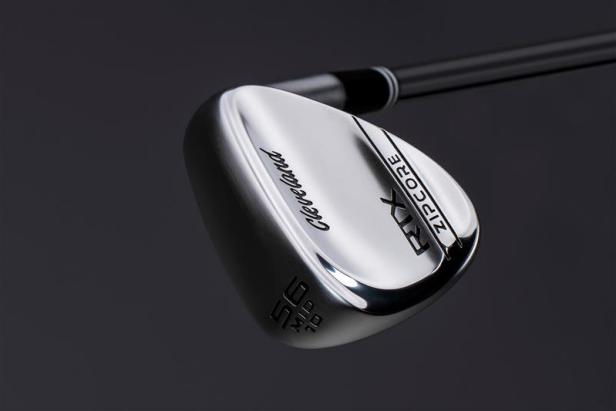The simple nature of a wedge might lead one to believe that improving the design is like reengineering the spoon. Any enhancements would seem to be at best subtle, microscopic and borderline cosmetic, and generally reserved for those looking for the proper implement with which to consume their daily caviar intake. More importantly when it comes to wedges, which is perhaps the tool better players grimace most over its aesthetic, any new option can’t really be embraced if it appears to have been fooled around with too much.
So the new Cleveland RTX ZipCore looks to be as classic as any wedge the company has produced since it began churning out short-game clubs four decades ago. And that would be both completely correct and categorically wrong. Because the RTX ZipCore is as fundamentally different a wedge as not just Cleveland but any company has ever produced, even though you’ll likely never see that difference. The hope from Cleveland’s design team is you’ll only see it in the aspect most crucial to a scoring club’s performance: consistency.
The RTX ZipCore’s unique design works under the hood. Unlike the one-piece solid cast steel construction so common in the wedge market, or even the occasional wedge that might feature an elastomer filler of one kind or another in the back cavity, the RTX ZipCore uses a new low density material inside the lower hosel, neck and sole area that is four times lighter than the steel it replaces. Rather than being injected into the design, the compound, new to golf, occupies an asymmetrical shape that the rest of the wedge is cast around.
The purpose of the complicated bit of engineering is to take the weight saved and reposition it, so the center of gravity is better aligned with the sweet spot and the head rotates less on high and low misses. That means more distance and spin consistency, said Dustin Brekke, director of engineering, who said the process behind the RTX ZipCore’s design began well before the company’s previous wedge appeared on the market. It was not a design decision made lightly, he said.
“That’s a very sensitive area to be messing with design where the hosel necks into the head,” Brekke said. “By being able to cast around it we’re able to keep all the controls in terms of shaping, while seeing the significant design freedom to now put that mass in better places.
“We found a solution that can allow us to take out that weight without creating a durability challenge or a visual challenge or a sound and feel issue. And you need a material that isn’t too soft or too brittle but also can withstand having molten steel poured around it while holding its position.”
Cleveland has been using a deeper hosel bore and other shaping tweaks to get the center of gravity more centered on the face in its recent RTX3 and RTX4 wedges, but this design pushes that CG closer to center (50 percent closer compared to earlier RTX wedges) and also frees up more mass to add stability, or moment of inertia. The MOI focus here is about the stability for high and low mis-hits as opposed to the heel-toe mishits, which is less of a concern on wedge shots.
“With this generation we’re able to kind of split how we’re using some of this mass to benefit the high-low MOI quite significantly,” Brekke said, noting a 9 percent increase in the high-low MOI.
Of course, it wouldn’t be a new wedge without some kind of groove enhancement to improve spin. And again, this is not an insignificant development. The RTX ZipCore features more grooves than previous designs that are closer together.
“There’s essentially no parameter in our groove spec that stayed the same,” Brekke said. “All of our testing over the years has essentially allowed us to do that.”
Two extra grooves were added compared to past models to provide more groove edges catching the ball at impact, helping to grab the cover and generate more spin. There’s a slightly more V-shaped wall angle and a greater depth to funnel away moisture and grass debris for cleaner contact.
“To get sharper, deeper and closer together, we think we’re really attacking what are the groove rules and what are the performance correlations,” Brekke said. “I don’t think we could really say the sharper or the deeper or the more grooves at ball impact, one vs. another, is doing more. But our data is clear that sharper with a smaller edge radius has a strong relationship to increasing spin, deeper has a strong relationship to increasing spin and then the more grooves you can get on there, the more effect those two things are going to have on every shot.”
The RTX Zip Core casting process also includes a new heat treatment to improve durability of those sharper groove edges, as well as the company’s previously proven laser etched lines between each groove and the rotational milling pattern on the face. Those latter two elements are aimed at producing the ideal surface friction to enhance spin, as well.
As a wedge aimed and developed with the insight of its tour staff and better players, the array of offerings in RTX ZipCore features three distinct sole grinds and 16 separate loft/bounce combinations that range from 46 to 62 degrees. The Low grind features distinct heel, toe and trailing edge relief with just six degrees of bounce on loft options from 56 to 62 degrees. The Mid grind features an angled V-shape with trailing edge relief and bounce angles of 10 degrees and runs nearly the entire range of lofts from 46 to 60 degrees. The Full grind is shaped for best stability through the turf on full shots and allows the face to be opened up more easily. It features 12 degrees of bounce and is available on lofts between 54 and 60 degrees.
The RTX ZipCore debuts in stores Aug. 14 ($150) with a tour satin finish. Other finish options will be unveiled this fall.


